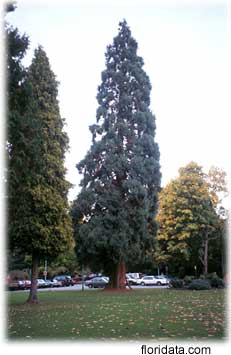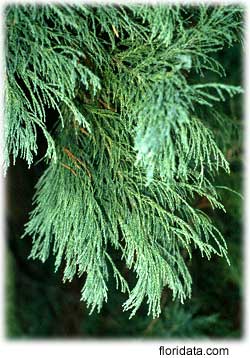Sequoia gigantea ( Giant Sequoia ) Tree Seeds
Find your zone using Garden Web's Zone Finder


Photos and cultural info courtesy of Floridata.com
John Muir called the giant sequoia "the noblest of a noble
race." The giant sequoia is a columnar or cone-shaped tree,
losing its lower branches and becoming flat-topped with age.
Trees more than 100 years old typically are free of branches to
a height of 100' or more. In cultivation, giant sequoias
usually grow no more than 60-100' tall and retain their lower
branches which may droop down to touch the ground and sometimes
take root. The reddish brown bark is very thick (up to 20"
thick) and deeply fissured.
The bright gray-green leaves are scale-like, sharp-pointed,
1/4" long, overlapping each other, and completely covering the
twigs. The egg shaped cones are 3" long, and remain on the tree
for up to 20 years. Unlike the related California redwood
(Sequoia sempervirens), giant sequoia does not sprout from the
roots.
Location: Giant sequoia grows naturally in isolated stands on the western slope of the Sierra Nevada range in central California, from 4,000' to 8,500' above sea level. The northernmost grove, consisting of six trees, is in Placer County, and the southernmost grove of 100 trees is in Tulare County, 260 miles to the south. The largest concentrations and best stands are in Kings Canyon and Sequoia National Parks, where there are whole groves of giant sequoias with trunk diameters exceeding 20' and heights exceeding 275'. These are truly majestic cathedrals that only God could make!
Culture: Giant sequoias are cultivated in Europe and eastern
North America as well as the US West Coast. They do best in a
moderately fertile, deep, well drained soil, in full sun to
partial shade. They like a cool climate. Giant sequoias grow
rapidly for the first few centuries, then slow down as they
surpass 150' in height.
Light: Full sun to dappled shade. Seedlings and young saplings
do best in partial shade.
Moisture: The average precipitation in the natural range of
giant sequoia is 45-60" per year, mostly from snow. Water young
specimens deeply and often.
Hardiness: USDA Zones 5 - 9. Has been reported to survive
temperatures of -22F in Scandinavia. Should be protected from
cold winter winds.
Propagation: Giant sequoia can be grown from seed. Best results
come from seed that has been soaked in water for 24 hours, then
chilled for 30-60 days before planting in mineral soil. Giant
sequoia also can be propagated by rooting soft wood tip
cuttings in summer and semi-hard cuttings in late summer.
Usage: The giant sequoia makes a magnificent specimen tree if
you have the room. In the eastern US, giant sequoia does much
better than California redwood.
Features: Sequoiadendron, like Sequoia, is a monotypic genus in
the baldcypress
The genus is named in honor of Sequoiah (1770-1843), the son of
a British merchant and a Cherokee woman, who became a Cherokee
chief and created an alphabet for his people's language.
Dendron is from the Greek for tree.
By nature, this is a low germinating seed, expect about 15-20 percent germination.

